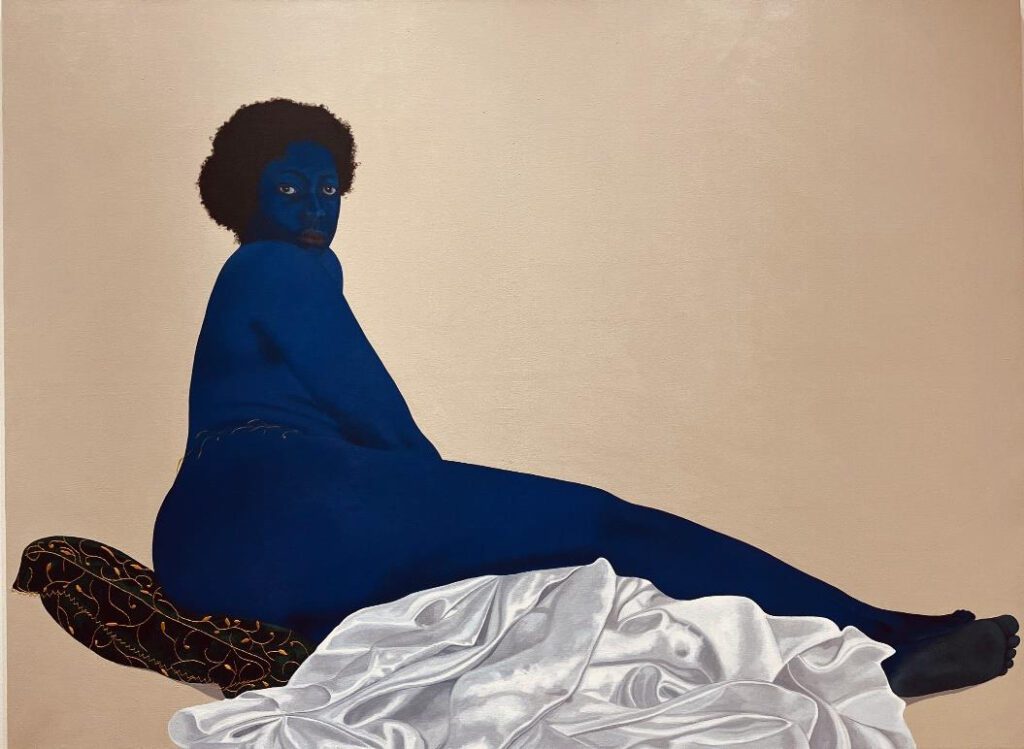
Margaret Lanterman
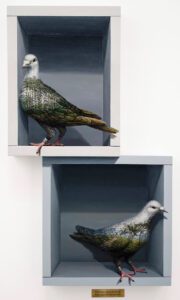
(2023) oil on wood panel 81.25x49cms
Art Expo 2023 once again was the bustling and vibrant international destination for artist and artwork – to see and be seen. This April the Chicago art community entered its eleventh year as a leading international art fair, which included a huge array of 170 international galleries from 36 countries. Not-for profit institutions, a discussion venue, and featured alignments throughout the city were also included. Across the city there were films, performances, after hours events and excitement in a week-long extravaganza that had something for every art interest.
With few exceptions, the exhibitors were open, friendly and quite willing to engage in informative private discussions. As this particular mile of presentations unfolded it became clear that something
bold and fresh drifted through the 2023 EXPO. It celebrated a commitment to the counterbalance of social issues and professional quality art while neither
overshadowed the other. Plunges into cultural heritage, prejudices, questions of respect, dignity and awareness were plentiful, insightful and timely, and were embedded as integral content of the high-quality art rather than as a message sitting on the surface. Environmental protection, climate change and personal involvement to that end was a significant theme to quite a few of the artists. Art and message were, in most cases, intertwined without grandstanding come-ons of shallow insight. Lush decorative art had meat on its bones, abundant portraits were with purpose, and history was represented with a continuity line. Impressive work by artists of color abounded, and some said ‘stole the show’.
A complement of additional sections was available. EXPOSURE catered to solo and two-artist presenters from younger galleries. PROFILE consisted of solo booths with projects of tight themes. EDITIONS + BOOKS was as titled. SPECIAL EXHIBITIONS represented a select few non-profit institutions, organizations and museums.
A sampling of topics featured in The Dialogue Discussion stage included the following: a conversation with Chance the Rapper and artist Hank Willis Thomas, which had standing room only. The two artists spoke of their work in community building that featured underrepresented artists and public art.
Madeleine Grynsztejn, Pritzker Director of the Museum of Contemporary Art Chicago (MCA), Dimitris Daskalopoulos, NEON founder and collector, and artist Brendan Fernandes presented their ideas for another session.
The Center for Native Futures focused on the building of organizations for Native communities in the U.S. and Canada. Curators of the 2023 Venice Architecture Biennale’s U.S. pavilion were featured in a rousing round table discussion. November witnessed the 18th Architectural Biennial, titled The Laboratory of the Future and was curated this year by Leslie Lokko. This is the first time that the spotlight has shone on Africa and the African Diaspora.
Richard Bell brought insights into his practice and the imagery of his protest art which exists alongside First Nation rights in Australia. The exhibition Forecast Form: Art in the Caribbean Diaspora, 1990s–Today– at the Museum of Contemporary art was explored via conversation with Carla Acevedo- Yates, the Marilyn and Larry Fields Curator at the MCA.
There was a discussion with LAXART Director Hamza Walker (SAIC Adjunct Professor) on his forthcoming exhibition, Monuments, which confronts the ramifications of white supremacy as represented in public sculpture. LAXART, a nonprofit visual art space in Los Angeles, is dedicated to developments in contemporary culture and incorporates exhibitions, publications, and public programs to this end. In 2005, Lauri Firstenberg responded to the need for a venue to represent under-recognized artistic talent when she opened LAXART.
There were hundreds of exhibitors and thousands of wonderful pieces of art. We commend all the artists and exhibitors for their accomplishments, and represent a glimpse of as many as possible in these pages. At the Marc Straus Gallery presentation, we came to the impeccable trompe l’oeil paintings of Clive Smith. It was hard to believe that they were fully smooth, two-dimensional paintings. While this artist was researching geometric structures, he came upon the work of molecular biologists who are endeavoring to re-create extinct species with a combination of preserved DNA and the closest living species-match. Being fully enthralled, Clive Smith decided to mix the appearance of existing bird species to the DNA of painting to create his own new and amazing species. Through the style and content of these paintings, it is unavoidable to consider our reckless threat to all endangered species and the void their loss continues to create.
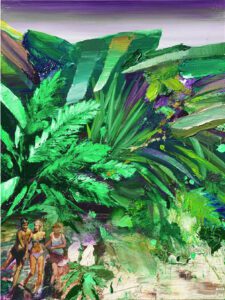
(2023) acrylic on canvas 48 x 36 cms
Not to be outshone in the content of bird conservation were the amazing bird anamorphs of Thomas Deininger, from the Ethan Cohen Gallery. As a wind surfer, it was unavoidable that he notice the huge mass of debris on the beaches below him. In his own statement to the catastrophic repercussions of human disregard for our environment, he created a series of sculptural objects which, seen from the side, clearly demonstrate a surreal jangle of strategically placed waste collected from the beach. Plastic skulls, shoes, cutlery, wire mesh- all examples of the debris he collected, are arranged in a strategic anamorph which, when seen from the front, appears as a very convincing and charming bird construction. Not only cheeky fun, but an engineering accomplishment that belies a strong aesthetic and moral statement are realized from these little gems.
Front view side view of anamorph construction In a painted match for material lushness comes the work of emerging artist Daniel Mendez, of Cuban descent and now living in Miami, Florida. Represented by Cernuda Arte, his heavily textured and brightly colored paintings sing with the light and plant life of his own environments. As thick as the foliage is it does not belie a psychological tension between the plants and the secondary focus of human figures, sometimes integrated into the scene and other times appearing as a seeming mis-match of thinly painted people within the foliage, painted in a more commercial style.
Belgium artist Gommaar Gilliam and DeBuck Gallery brought us the painting In from the Night they Come and Go, part 3. This is a visually compelling painting that seems stylistically familiar and yet challenges us with wonderment over the myths and imagery present. Imagery is informed by both mid-east and European symbolism. Closer viewing tells us that this work actually challenges traditional abstract expressionistic style with a contemporary combination of techniques and materials. Canvas first dyed with acrylic is stitched together to provide the painting surface for a contemplation of meanings of social conflict, fairytale symbolism and longing.
De Bruck Gallery displayed work of far-flung variety, and one piece that contrasted with the painterly Gilliam piece was an arresting item by Zak Ove. This large two-dimensional collage-doily piece stood out for its contemporary take on traditional everyday lives. Clever use of color and texture incorporate daily Caribbean home-usage of crocheted doylies to create a strong composition. The work of Ove incorporates the African diaspora through his life in Trinidad, London and beyond in his dialogues using art to go between past, present and future political life. The layering effect put this viewer in mind of the stacked fabric art of the Guna peoples of the Panama area, where two-seven layers of colorful fabric are carefully layered, and incised shapes are cut out to reveal striking traditional imagery.
A very quiet yet powerfully compelling work by Nate Young, Monique Meloche Gallery, was constructed with master craft and combined a handmade rectangle of tinted glass with a small gestural drawing of a man and horse. These figures float in a largerspace that appears to be a perfectly proportioned environment for them. A wooden structure divides the space and also serves as a frame. Young is known for expressing ideas of race and theological thought, especially in a sense of shaping beliefs. In this work he implies no definitive content, but rather a poetic suggestion. This work has a sense of vastness even while the Guan Mola traditional art, anonymous Nate Young, Detail, graphite on vellum small figures are situated intimately in the space, giving an awareness of a void and a fulfilled space at the same time- poetic and philosophical, meditative and approachable.
Looming over visitors from the Kavi Gupta Gallery space was the huge painting, Loretta (Ms. T) by AlfredConteh. In the forefront of American portraiture, this Georgia, USA native selects his subjects
from his life encounters and tells the stories of the disparities that have been affecting their communities, and of the troubles that they have faced in theSouthern US. His long ongoing series Two Fronts places his carefully observed subjects in simple environments that emphasize their identity. He often includes unusual elements such as battery acid, soil, melted plastic and rust, with deft skill, to emphasize their living conditions and the rough state of the
environment that is their home.
The subject of this portrait is a woman with a reportedly sweet demeanor who chose to demonstrate fierceness, which is the topic of one negative stereotype of Black women.
We realize that as the background of this painting seems to peel off, Loretta is in fact somehow merged into it. Slashed canvas was an effective feature of the painting by Cristina Camacho, Instituto de Vision Gallery. A top layer of canvas was painted on both sides and strategically cut and turned to reveal the bottom layer of canvas.
The effect is one of tactile richness and unexpected dimensions of both flat and high relief with a lively exchange of shape and color between them. Ceramic art was not in abundance at this exhibit, although some notable works were present. Such was the case with Burnt Yams Barn II, a large-scale wall installation by Nigerian artist Ozioma Onuzulike, with KO Gallery. Onuzulike has been tireless in his scholarly accomplishments with the prestigious Nsukka School in Southeastern Nigeria, and with his determination to use the metaphysical and mechanical nature of clay work (hammering, wedging, burning, cutting etc.) to communicate the oppressive socio-political and environmental issues, terrorism and climate change that are daily challenges for the people of his homeland. The work has a compelling aesthetic appeal that draws one in to examine it further; to explore the texture, composition and evidence of human labor – and ultimately the sense of claustrophobia, damage and use that may also be attached to the associated humans.
The glossy ceramic sculptures of Bari Ziperstein at the Vielmetter Gallery exhibit were the first things you saw as you entered Expo from the east. This work was in high contrast to that of Onuzulike in that they are traditionally produced with high gloss glazes and bright colors. What these two clay artists have in common with each other is that both speak of their roots. Ziperstein focused her work on Brutalist architecture, family history, Soviet propaganda and the politics of aesthetics. Along with architectural-referencing sculptural objects were a series of heavily worked, squarish wall reliefs. All the objects incorporated vivid colors, texture, carved surfaces and active patterns that make them playful and full of joy despite a sometimes-oppressive subject.
A piercing gaze shines out from the paintings of Stacey Gillian Abe of Unit London Gallery. Figures depicted in the bluest black imaginable are a sensory experience. The figures seem to be at rest, and aware of being viewed. Powerful emotions drift out gently from each figure and the gaze is frank and accepting. The subjects fill the canvas to a point where little background is necessary and the open space provides a cushion for the viewer to acknowledge their own reactions to this bold work.
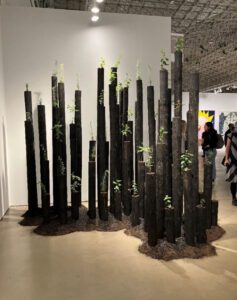
55 Shou Sugi Ban posts, indigenous plants, indeterminant size
Painterly and tactile, Mathew Eguavoen is a Lagos-based artist who explores issues of vulnerability, closeness and youth, gender and history.
Color here is acid sharp with strong contrast. Composition is key as he pulls the viewer in to investigate what he is telling them through these thoughtful and emotion-packed works at Badr El Jundi Gallery.
Tony Fitzpatrick has a genius for detail and a love for the street culture of his hometown, Chicago, which is often the subject of his work. This print, There is a Dog that Remembers the Stars and My Dad, presented by Chicago Printmakers Collaborative, explores Chicago from a street level view. He takes the viewer through many minute details of his life; the stories he has lived, has heard and told. He collages not only the images, but also a variety of styles. We can see realism alongside surrealism and ordinary iconography mixed with a graphic novel sensibility. Each little symbol stands alone but eventually integrates into the thread of the narrative.
In the Special Exhibit section, HOW ON EARTH was a climate-focused exhibit meant to inspire the viewer, through the artwork, to take action and thereby generate hope for our planetary future.
Featured were acclaimed artists and activists Janet Biggs, Lily Kwong, Helina Metaferia and Jennifer Wen Ma. This exhibit space featured prime examples of art from each artist with the exception of the large installation of Jennifer Wen Ma, which greeted guests outside as they entered Art Expo.
These artists have been committed to environmental content in the projection of their artistic voices. The art exhibit was accompanied by several associated events including a panel discussion, The Chicago Dancemakers Forum performance and a pop-up Experimental Sound Studio performance. It was presented by two organizations:
the Natural Resource Defence Council, an international organization with over three million members that endeavors to protect the environment with legal, scientific and environmental specialists; and Art At A Time Like This, a non-profit organization that was born during COVID to work for dialogue and heightened understandings of different perspectives among global and local audiences.
Included is the art work of Janet Biggs, whose work is research based and immersive. Her works traverse the borders of science, art, culture and technology. Presented here is her 2018 video, Weighing Life Without a Scale, where three screens are filled with videos of distant and harrowing situations which enter into our consciousness. In making these videos, Biggs immersed herself with the individuals who lived in extreme and dangerous landscapes such as parts of Afghanistan, or with dangerous situations that required intense training and study. To continue her investigation of life in hostile environments she worked to become a member of crews at the US Mars Desert Research Station. Through her visually rich and episodic videos one can connect to challenges of life far from our usual
imaginations.
Lily Kwong, of Los Angeles brought us a botanical installation, MOTHERFIRE, inspired by the largest California forest fire, the August Complex Fire. It is
composed of fifty-five burned-out posts incorporating Shou Sugi Ban (an ancient Japanese architectural technique involving fire). Each charred post now provides a growth base for new indigenous plant life. This installation speaks not only of devastation, but also of the immense ability for forest systems to regenerate. This sculpture installation presents on a more cerebral level than the previous design work of Kwong.
Jennifer Wen Ma, Beijing and New York, greeted the public outside of the east entrace with her arresting installation, Turn of the Tide. Constructed of paper and designed to deteriorate in response to its direct exposure to the Lake Michigan environment, this piece speaks of the pollution of our waters and the growing threat of destruction and erosion due to climate-change induced sea level rise.
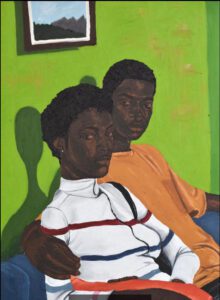
acrylic, oil paint, charcoal graphite pencil 130x100cms
Lily Kwong, Motherfire, 55 Shou Sugi Ban posts, indigenous plants, indeterminant size Each of the collaged portraits of Helina Metaferia, New York, are composites of archives and dialogue with the subjects, all who are active in the cause that Metaferia presents through her collage photos. In Metaferia’s
Headdress 55 and Headdress 56, two women activists are crowned with an elaborate headdress comprised of many small images composed together, each piece symbolizing some aspect of their cause. These four women, working in various venues, are united in their effort to bring environmental conservation and social conscience to the forefront with their artwork
One other Special Exhibit space deserve comment for exceptional work with youth through art. The Chicago Public School System (CPS) is the third largest in the country and so, in its vastness, many excellent programs go without proper recognition. CPS Lives is one such program that matches artists to a specific school for a year, awakening children to their creative selves and connecting them to art as a way to reach deeper thought and understanding. Ludwig Peres is one of the many resident artists who
sought input and collaboration from students in the art-making process; in this case, 3-D photo art.
A person could have spent much more than a week of days at the 2023 Art
Expo and still not have taken in all that was on offer. It was an expansive view of what artists the world over have to offer, and one hopes this trend continues in future years.

